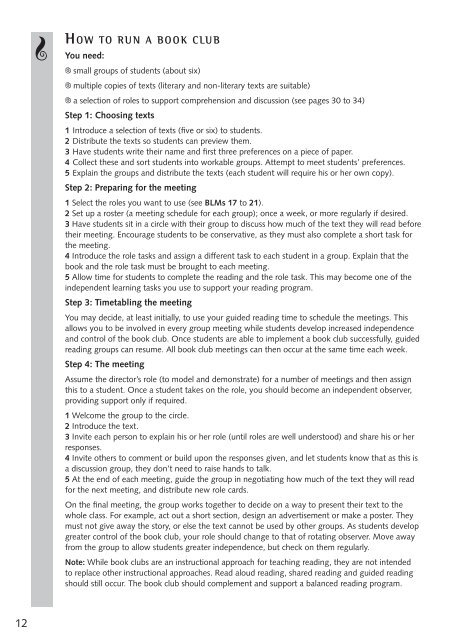All You Need To Teach Comprehension 10+
You also want an ePaper? Increase the reach of your titles
YUMPU automatically turns print PDFs into web optimized ePapers that Google loves.
H ow to ru n a bo o k clu b<br />
<strong>You</strong> need:<br />
@ small groups of students (about six)<br />
@ multiple copies of texts (literary and non-literary texts are suitable)<br />
@ a selection of roles to support comprehension and discussion (see pages 30 to 34)<br />
Step 1: Choosing texts<br />
1 Introduce a selection of texts (five or six) to students.<br />
2 Distribute the texts so students can preview them.<br />
3 Have students write their name and first three preferences on a piece of paper.<br />
4 Collect these and sort students into workable groups. Attempt to meet students’ preferences.<br />
5 Explain the groups and distribute the texts (each student will require his or her own copy).<br />
Step 2: Preparing for the meeting<br />
1 Select the roles you want to use (see BLMs 17 to 21).<br />
2 Set up a roster (a meeting schedule for each group); once a week, or more regularly if desired.<br />
3 Have students sit in a circle with their group to discuss how much of the text they will read before<br />
their meeting. Encourage students to be conservative, as they must also complete a short task for<br />
the meeting.<br />
4 Introduce the role tasks and assign a different task to each student in a group. Explain that the<br />
book and the role task must be brought to each meeting.<br />
5 <strong>All</strong>ow time for students to complete the reading and the role task. This may become one of the<br />
independent learning tasks you use to support your reading program.<br />
Step 3: Timetabling the meeting<br />
<strong>You</strong> may decide, at least initially, to use your guided reading time to schedule the meetings. This<br />
allows you to be involved in every group meeting while students develop increased independence<br />
and control of the book club. Once students are able to implement a book club successfully, guided<br />
reading groups can resume. <strong>All</strong> book club meetings can then occur at the same time each week.<br />
Step 4: The meeting<br />
Assume the director’s role (to model and demonstrate) for a number of meetings and then assign<br />
this to a student. Once a student takes on the role, you should become an independent observer,<br />
providing support only if required.<br />
1 Welcome the group to the circle.<br />
2 Introduce the text.<br />
3 Invite each person to explain his or her role (until roles are well understood) and share his or her<br />
responses.<br />
4 Invite others to comment or build upon the responses given, and let students know that as this is<br />
a discussion group, they don’t need to raise hands to talk.<br />
5 At the end of each meeting, guide the group in negotiating how much of the text they will read<br />
for the next meeting, and distribute new role cards.<br />
On the final meeting, the group works together to decide on a way to present their text to the<br />
whole class. For example, act out a short section, design an advertisement or make a poster. They<br />
must not give away the story, or else the text cannot be used by other groups. As students develop<br />
greater control of the book club, your role should change to that of rotating observer. Move away<br />
from the group to allow students greater independence, but check on them regularly.<br />
Note: While book clubs are an instructional approach for teaching reading, they are not intended<br />
to replace other instructional approaches. Read aloud reading, shared reading and guided reading<br />
should still occur. The book club should complement and support a balanced reading program.<br />
12


















